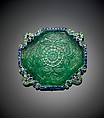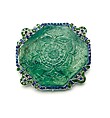Brooch with Carved Emeralds and Sapphires by Cartier
Cartier French
In 1911 Jacques Cartier, head of the London branch of the family firm, traveled to India to source gems and cultivate Indian clients. By the 1920s, socialites in Europe and the United States as well as men and women of the Indian nobility were sporting Mughal gems in settings fashioned by Cartier and other European jewelers. To this day, Cartier and other elite jewelers in Europe and India have continued to use Mughal gems as the centerpieces of their creations.
This large octagonal Mughal emerald is decorated with a carved lotus blossom rosette and four leafy stalks extending in the cardinal directions. The stone itself is thin, having been cut down, perhaps in the early twentieth century, when it was set in a platinum mount by Cartier. Although the stone originally may have been set in a bazuband, armor worn by men on the upper arm, Cartier repurposed it as a brooch, presumably for a woman. Along the edges of the octagon, square cabochon sapphires alternate with an emerald-set arch enclosing a trefoil of three round cabochon sapphires and terminating in emerald volutes, intersected on each side by two sapphires. The brooch may have been made for one of Cartier’s American clients.
Due to rights restrictions, this image cannot be enlarged, viewed at full screen, or downloaded.
This artwork is meant to be viewed from right to left. Scroll left to view more.



